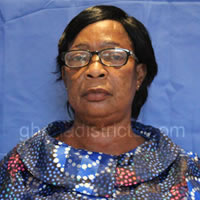There are two main categories of roads in the district giving a total length of 196 kilometres. The first category is the primary road from Chuchuliga to Fumbisi, covering about 47km, of which 5km is surfaced with bitumen. The rest of the road network comprises mainly feeder roads linking the major settlements with each other. Intra-settlement communication is by footpaths and tracks.
Sandema, the district capital has postal services to the whole district. With Ghana Telecom’s on-going nationwide expansion programme, plans are far advanced to upgrade the postal agency into a modern post office with automatic telephone exchange and expedited mail services (EMS). The district will also be linked to the rest of the country by Microwave Radio Relay System. On the whole, nominal coverage of potable water in the district is about 81%. There are 165 domestic pipes, 16 public standpipes, 170 boreholes and 158 protected wells in the district. Sandema and Chuchuliga have pipe-borne water systems whilst the other communities have boreholes and hand-dug wells.
In spite of the high nominal coverage however, actual water supply is inadequate and seasonal. Currently, Sandema and Chuchuliga are the only twos settlements in the district served with electricity from the national grid. There is, however, an on-going rural electrification programme to extend electricity to most other key settlements. In Builsa District, many of the houses are constructed with locally available materials. About 90% of the housing stock are built with mud and roofed with thatch. Only 10% of the houses, mostly official residences, are roofed with aluminum. Efforts are being made by the District Assembly and SSNIT to build higher quality houses in the district.
The district currently has one government hospital at Sandema, three health centres and two community clinics. In addition, mobile health teams from Sandema and the other health centres visit several villages on a routine basis to offer health services to the people at 74 outreach clinic points. The district has one community bank, BUCOBANK, operating in Sandema.
It operates a wide range of banking hall services. Credit is also available through the bank from the District Assembly’s fund for productivity and income generating activities. The district has two major periodic markets, namely Sandema and Fumbisi markets, which operate every three days and every six days respectively. There are several other periodic minor markets in the district.
Road Infrastructure
The principal mode of physical access into and within the District is by roads. There are two main categories of roads in the district giving a total length of 146km and a road density of 0.09%. There is one major artery or primary road from Chuchuliga (Tono Bridge) to Gbedembilisi, which is about 81km (50 miles), about 11km of which has been surfaced with bitumen.
The rest of the road network is basically a feeder road linking major settlements to one another. To some extent inter settlement communication is by footpath and tracks. With the exception of the major artery, (Sandema-Gbedembilisi) and a few of the secondary roads, e.g. Sandema –Doninga-Bachonsa, Wiaga-Kadema and Fumbisi-Kanjarga) the rest of the road network is in a very deplorable state especially in the rainy seasons.
Transportation Services
The Metro Mass Transit (MMT) service operates a safe, efficient and affordable transport service in the district. Three buses convey people and goods to and from Bolgatanga through Chuchuliga, Navrongo and other settlements three times a day for every day of the week. They follow their fixed schedules, starting at 6:30am to about 6:00pm.
This service has brought a lot of transport relief to the Builsa people. Over 600 people use MMT’s Bolgatanga-Sandema route service daily. Taxis and other mini-buses also provide similar services. On every market day, one MMT bus leaves from Sandema to Kumasi at 11:30am. An MMT bus also operates from Fumbisi-Accra and Fumbisi-Kumasi on every Fumbisi market day. Apart from the Sandema-Chuchuliga route, transport service from Sandema to other communities like Siniensi, Wiaga and Fumbisi are carried out by old buses most of which are generally road unworthy.
Road
On-going spot improvement of 25km feeder roads at the cost of 1,161,830,000.00
On-going rehabilitation of Sandema-Doninga, Sandema-Kori Roads at the cost of ¢470.887,630.00
Completion of Sandema-Chiana Roads at the cost of ¢392,294,000.00
Electrification
Provision of electricity has catalysed the economic development of several cities around the world. Presently Sandema, Chuchuliga, Wiaga, Kadema and Fumbisi are the only towns in the district served with electricity from the National Grid. There is however an on-going rural electrification programmes to extend electricity to most other key settlements including, Wiesi, Kanjarga and Siniensi.
Fuel Stations
There are no modern fuel stations in the District. Motorists have to resort to the local fuel tank stations who store the fuel in barrels and other tanks. There are about ten (10) of such installations in the district, four of which are in Sandema.
Energy
Street lighting to Sandema and Chuchuliga townships at the cost of ¢229,900.000.00
Social Services
- Completion of Sandema Police Station, Rehabilitation of DCE’s bungalow, provision of furniture and furnishing of DCE and DCEs bungalows at the cost of 0394.761,725.00.
Under construction of 2 markets, Fumbisi Guest House and cladding of 2-Pavilions at Wiasi at the cost of 0972,863,178.00.
Post & Telecommunication Infrastructure
Sandema, the District Capital has a Postal Agency that offers postal services to the whole district. Facilities in the Agency are however seriously limited. There is the need for the construction of a modern post office with state-of-the –art equipment to provide expedited mail service to the 75,375 people of the district.
Up to the end of 1999, there was no telephone facility in the Builsa District. In May 2000, UNICEF donated a cordless radio Phone (Expoma Equipment) with two lines to the District Assembly.
One of the lines was installed in the Central Administration Office Block for use by the staff, while one was installed in a Telecommunication centre to provide telephone services to the general public.
Through series of negotiations and hardwork, Ghana Telecom linked up Sandema to the automatic Exchange system in April 2002 when it constructed and installed a mini transmission station with a limited capacity of 15 lines.
Installation of the facility marked the beginning of the economic transformation of the district since it allowed quick transmission of messages to enable Businessmen, Government Officials, and the general public take advantage of otherwise missed business opportunities.
Presently (2002), besides Institutional Telephone facilities, there are 6 private telecommunication centres in Sandema, that offer International Direct Dialing Services to people who hitherto had to travel between 18 and 36 miles to Navrongo or Bolgatanga to make calls. At least two of the commercial communication centres provide fax services.
Though installation of the Telecommunication system is an indicator of the economic development of the District, the limited nature of the facility at the moment requires that the system be expanded to meet demand from the ever-increasing subscribers and to also link-up the district to the Internet.
There is also the need to link the District to the rest of the country by microwave Radio Relay System to enhance communication besides the provision of trunk dialing facilities. The radio links have the advantage of providing teleprinter channels for quick transmission and reception of telegraph and telex messages.
Market Infrastructure
Builsa District has two major periodic markets namely Sandema and Fumbisi and several smaller local markets.
Sandema market operates every three (3) days whilst Fumbisi operates every six (6) days. The other localized markets are Wiaga, Chuchuliga, and Doninga etc, all of which are periodic.
The periodic markets in the district operate in groups in what is termed as Ring system that works in such a way that neighboring markets do not compete with each other on the same day and that no settlement is unduly excluded from a market within a week. This arrangement expresses an intelligent mutual self-interest among neighboring settlements.
The smaller rural markets act as collecting and organizing points for the wide range of agriculture produce including groundnuts, shea nuts, rice, millet sorghum, guinea corn, cattle, sheep and goats which are channeled to Fumbisi and Sandema, which in turn serve as intermediaries for on ward transmission to the larger national cites like Tamale, Accra, Kumasi, Takoradi etc. the basic function of the Fumbisi and Sandema markets are the bulking and redistribution of commodity within and outside the district.
The location of these major marketing centres particularly Fumbisi, in the heart of the vast and highly productive livestock and food cropping zones of the District enhances their attractiveness and thus account for their great sphere of influence and growth. Fumbisi and Sandema are in fact regional markets whilst the rest are appropriately described as local markets.
Problems / Issues
In spite of their immense contributions to the district’s economic growth, all the markets are seriously beset with a number of problems: These are:
1. Inadequate number of stores, stalls and sheds
2. Poor/dilapidated structures, leaking roofs etc
In Sandema and Fumbisi, between 60-70% of buyers and sellers operate in the open without any shelter. For Wiaga and Chuchuliga, between 70-80% of the transactions take place in the open. The implications are that markets close down during the rains and thereby lead to revenue loss to the buyers and sellers as well as the District Assembly.
Poor Sanitation; Lack of waste disposal facilities like toilets, refuse damps, urinals etc result in indiscriminate disposal of solid and liquid waste in the markets. The resultant adverse health implications are enormous and include the spread of water-borne and water related diseases like Diarrhoea, cholera, intestinal worm infestation.
Suggestions
Serious efforts must be made to develop the physical infrastructure of the markets besides providing basic social facilities like toilets, refuse dumps, electricity, water etc.
Road Infrastructure
Surface Accessibility
The principal mode of physical access into and within the District is by roads. There are two main categories of roads in the district giving a total length of 146km and a road density of 0.09%. There is one major artery or primary road from Chuchuliga (Tono Bridge) to Gbedembilisi, which is about 81km (50 miles), about 11km of which has been surfaced with bitumen. The rest of the road network is basically a feeder road linking major settlements to one another.
To some extent inter settlement communication is by footpath and tracks. With the exception of the major artery, (Sandema-Gbedembilisi) and a few of the secondary roads, e.g. Sandema –Doninga-Bachonsa, Wiaga-Kadema and Fumbisi-Kanjarga) the rest of the road network is in a very deplorable state and very few tracks are motorable/passable during the peak of the rainy season, a situation, which seriously reduces the level of accessibility in the District.
As noted in Section 1.1.2.2 above the main contributory factor is the heavily dissected nature of the area coupled with the low-lying terrain and soft surface soils which make most road links flooded and sometimes completely washed-off during the rains.
Road network development is of prime importance and will involve heavy capital investment in construction of culverts, bridges, and reshaping of tracks among others.
Date Created : 11/20/2017 3:54:02 AM





 facebook
facebook X (twitter)
X (twitter) Youtube
Youtube +233 593 831 280
+233 593 831 280 0800 430 430
0800 430 430 GPS: GE-231-4383
GPS: GE-231-4383 info@ghanadistricts.com
info@ghanadistricts.com Box GP1044, Accra, Ghana
Box GP1044, Accra, Ghana